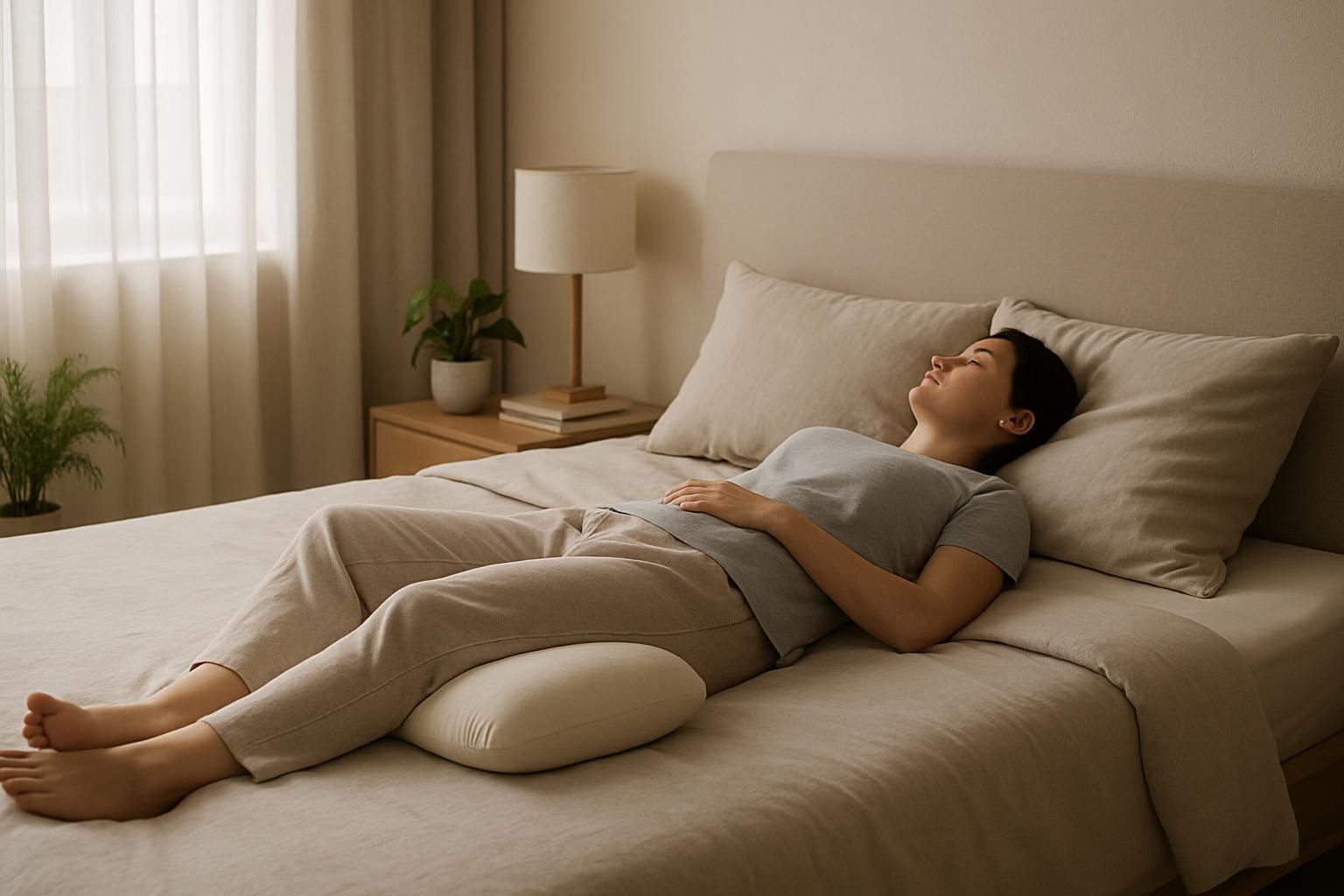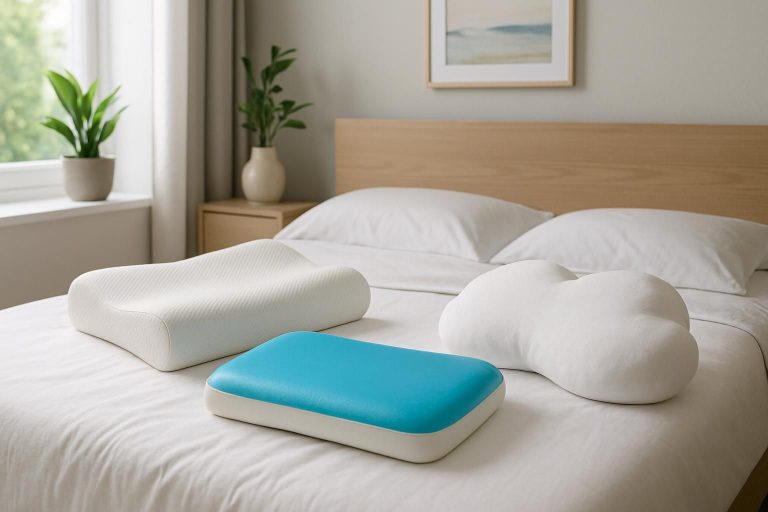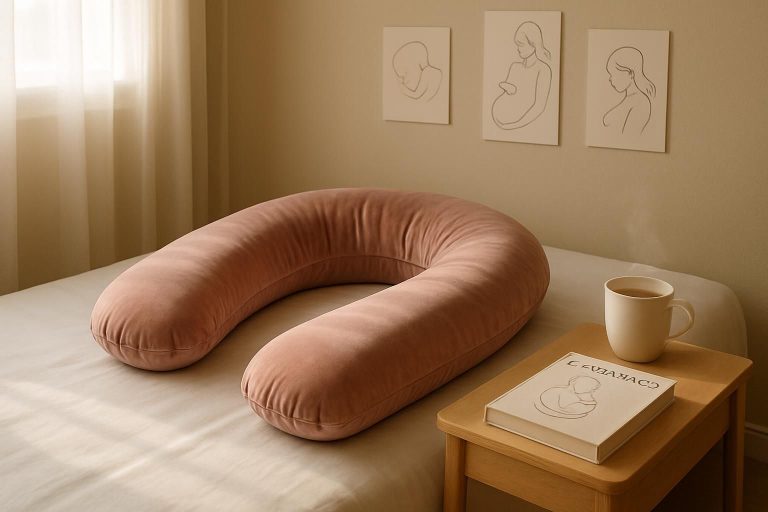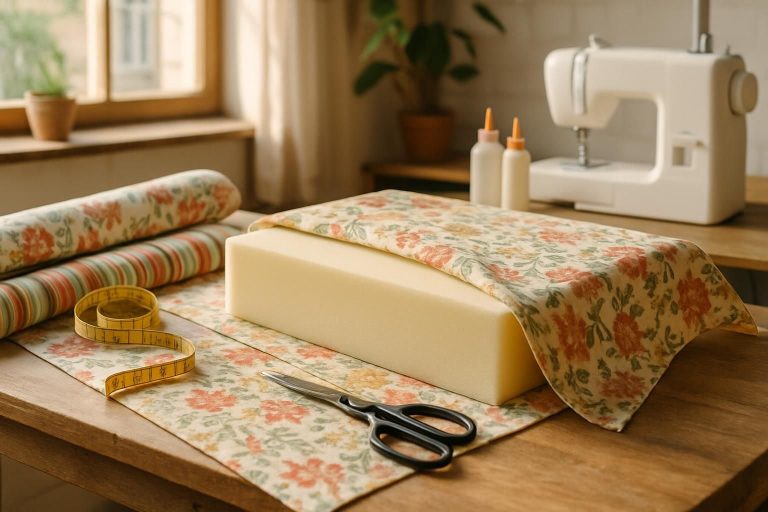A restorative sleep remains a fundamental pillar for overall health and daily well-being. Yet, the quality of nighttime rest is often affected by inadequate sleeping positions, leading to aches or tensions, especially in the back, hips, and legs. In this regard, sleeping with a pillow between the legs proves to be a simple yet powerful tip for improving not only comfort but also spinal balance throughout the night. This gentle and accessible solution helps prevent discomfort and optimizes physical recovery, promoting a stable position that respects the joints. Whether for people suffering from lower back pain, those dealing with sciatica, or pregnant women, adopting this small accessory proves beneficial and contributes to better, long-lasting sleep quality.
Why sleeping with a pillow between the legs improves sleep quality 💤🛏️
Connection between sleep posture and physical well-being: back, hips, and legs 🦴💪
The position adopted during sleep directly influences physical comfort upon waking. Poor posture can cause or worsen pain in sensitive areas like the back, hips, and legs. Indeed, uneven weight distribution and joint torsion generate muscle tensions and chronic pain, particularly in the lower back. Using a pillow between the legs acts as a natural stabilizer and helps maintain optimal alignment.
The pillow placed between the legs:
-
Maintains the pelvis in a neutral position 🦴
-
Preserves the natural alignment of the spine 🛏️
-
Reduces stress on the hips and knees 💪
-
Limits uncomfortable rotations during sleep 😴
This device is especially recommended for side sleepers. By preventing the upper leg from pulling on the pelvis, it ensures a more balanced position that respects the natural curves of the back.
Reducing lower back and sciatica pain: practical explanations
Lower back and sciatica pain are often linked to sleep positions that cause pelvis torsion or nerve compression. In side sleeping, the upper leg tends to push forward or backward, misaligning the lower back and creating tension on the sciatic nerve. The pillow between the legs prevents this movement, thereby reducing pressure on sensitive areas.
For example:
-
The pillow limits the risk of sciatic nerve irritation, which can cause numbness or intense pain 🦵
-
By keeping the knees slightly apart, it eases pressure on the intervertebral discs and helps prevent herniated discs 🚫
-
It calms muscular tensions in the lower back, facilitating pain-free waking
A correctly positioned sleep thanks to the pillow is therefore a first step toward long-term improvement of chronic pain.
Side sleeping: the pillow trick to prevent pelvis torsion
Since side sleeping is the most common position, it’s frequent that without support, only body weight unbalances the posture. The pelvis tends to tilt or rotate, compressing joints and causing pain in the hips or knees. Placing a pillow between the legs provides a physical barrier and natural stabilization.
|
Effect of the pillow |
Beneficial consequences 🛏️ |
|---|---|
|
Maintains the pelvis in a neutral position |
Reduces tensions in the hips |
|
Supports the knees apart |
Decreases joint pain 😌 |
|
Aligns the spine |
Improves sleep quality |
Adding this pillow helps limit nighttime muscle fatigue and prolongs the feeling of well-being upon waking.
Promoting blood circulation during the night with the pillow ❤️
Less pressure between the legs: benefits for heavy-legged legs and muscle recovery
The constant pressure of one leg on the other during the night hampers proper blood circulation, causing sensations of heavy legs and muscle fatigue. The pillow placed between the legs reduces this phenomenon by preventing direct contact, encouraging venous return and oxygenation of the muscles.
-
Reduces the feeling of heaviness in the legs 🦵
-
Improves muscle recovery after an active day 💪
-
Prevents nocturnal circulatory issues
Better blood flow during sleep thus limits pain, cramps, and accumulated fatigue.
Reducing nighttime swelling and tingling: why it’s essential
Swelling, often linked to poor circulation, can develop overnight due to prolonged pressure on certain vessels. The pillow plays a key role here by reducing this compression, preventing edema and uncomfortable tingling.
The benefits include:
-
Less numbness and tingling upon waking 💤
-
Lower risk of circulatory problems
-
Better feeling of lightness in the legs
Waking up without these discomforts greatly improves sleep quality and the ability to start the day energized.
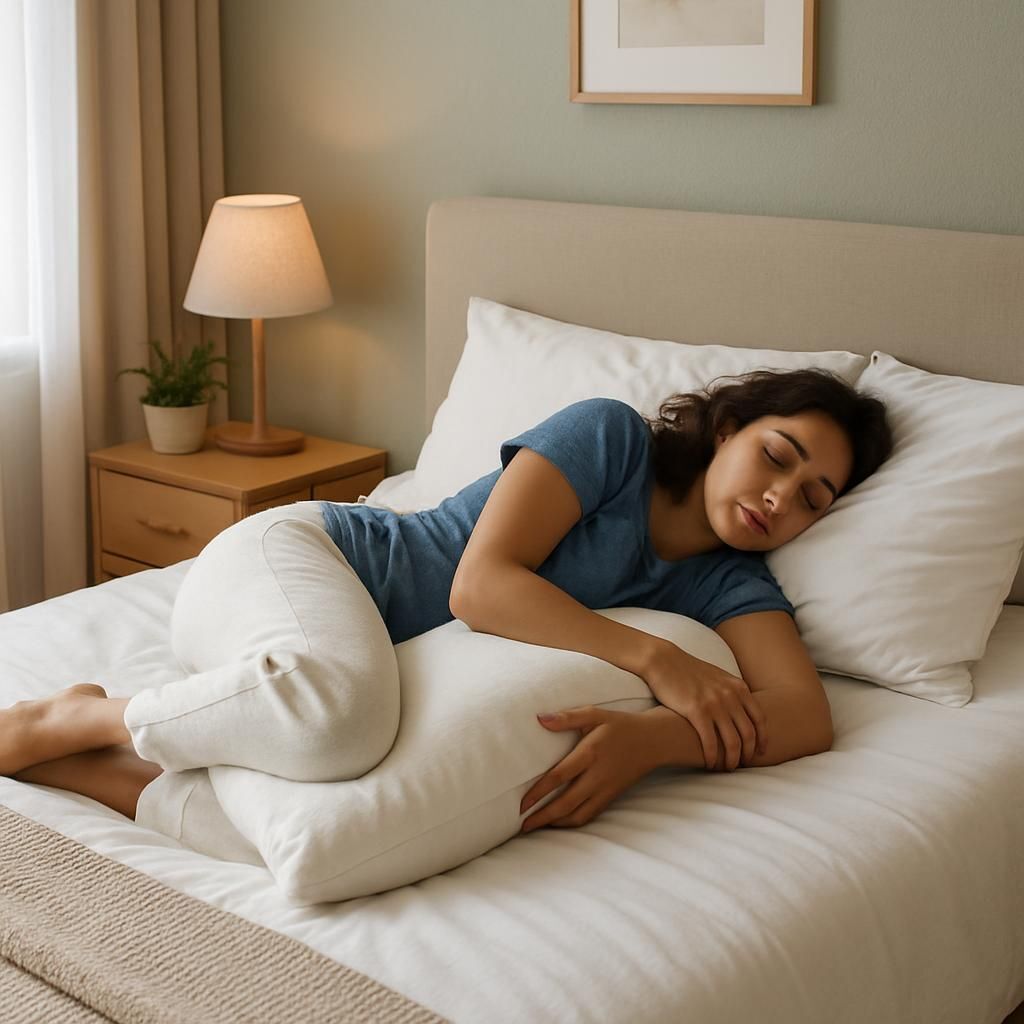
Choosing the right pillow for sleeping between the legs: essential criteria 🛏️🦴
Shape, size, and material: optimizing comfort and support 😴
The choice of pillow is crucial to maximize its beneficial effects. Several factors must be considered to ensure optimal comfort and proper support.
Criteria to consider:
-
Shape: triangular, hourglass, or ergonomic to better contour to the legs
-
Size: large enough to effectively separate the knees
-
Material: memory foam recommended for long-lasting support
-
Cover: removable and washable for perfect hygiene
Memory foam absorbs pressure without collapsing, ensuring consistent support throughout the night. Additionally, it adapts to the contours of the knees and legs, increasing overall comfort.
Memory foam, washable covers: top choices
Opting for a memory foam pillow offers:
-
Precise adaptation to the shape of the legs and knees 🦵
-
Excellent durability over time
-
Reduction of pressure points
Removable covers make maintenance easier, which is essential to preserve the freshness and quality of the pillow.
Adjust thickness and shape to your morphology for restorative sleep
Everyone’s profile is different. The ideal thickness depends notably on:
-
The width of hips and legs
-
The necessary firmness to prevent the pillow from flattening
-
Personal preferences regarding touch and support
A pillow that is too thin does not effectively separate the knees, while an overly thick pillow can cause paradoxical tension. It is therefore important to test several options to find the one that promotes the best spinal alignment and maximum comfort.
|
Pillow type |
Advantages 😴 |
Best for |
|---|---|---|
|
Triangular |
Good pelvis stabilization |
Side sleepers |
|
Hourglass |
Comfort around the knees |
People with sensitive knees |
|
Ergonomic |
Targeted support for the spine |
Lower back pain or disc herniations |
Sleeping positions: side, back, and specific cases 🤰
Pregnant women: suitable pillow to relieve back and hips
For pregnant women, posture changes due to the growing belly often cause back and hip pain. Using a pillow between the legs helps stabilise the pelvis and reduce pressure on the lower back. Special pregnancy pillows also provide overall support, considering the belly and legs for maximum comfort.
-
Improves posture support
-
Reduces pain associated with joint pressure
-
Promotes better blood circulation, reducing swelling
Using the pillow under the knees when sleeping on the back
For back sleepers, a pillow between the legs is less recommended. However, placing a pillow under the knees helps limit excessive lumbar lordosis, thereby reducing back pain. This variation helps relax lower back muscles and promotes a better overall position.
|
Sleeping position |
Use of the pillow |
Key benefits |
|---|---|---|
|
Side |
Between the legs |
Aligns the spine, reduces pain, stabilizes the pelvis |
|
Back |
Under the knees |
Reduces lumbar strain, promotes relaxation |
Below is the translated version in Canadian English, with no changes to the HTML tags: Sous les genoux
Decrease lumbar arching, relief for lower back
Pregnant women
Between the legs or full pregnancy cushions
Reduce pressure on back and hips, improve circulation
Practical Tips to Maximize the Benefits of the Between-Legs Cushion 😴💪
Pairing the between-legs cushion with an appropriate pillow for spinal alignment 🦴🛏️
The importance of a proper head pillow to support the neck and prevent cervical pain
The between-legs cushion is just one part of the equation for quality sleep. The pillow plays an equally crucial role in maintaining spinal alignment, particularly in the cervical region. An appropriate pillow keeps the neck in a natural axis, preventing twists that could cause pain and tension upon waking.
A good pillow should:
-
Support the head according to sleep position (side, back)
-
Respect the natural curve of the neck 🦴
-
Be neither too firm nor too soft to avoid cervical tension
-
Promote deep, restorative sleep 😴
Risks of a poor pillow: sleep disturbances and muscle tension
Choosing an inappropriate pillow can negate the benefits of the between-legs cushion. For example, a pillow that is too low can exacerbate cervical pain, while a pillow that is too high can distort posture and cause muscle tension in the neck and shoulders. Over time, this can impair sleep quality and increase night awakenings, worsening back pain.
Tips for correctly positioning the cushion and adopting the best posture
Placing the cushion to stabilize the pelvis and knees overnight
To maximize the benefits of the cushion, it’s important to position it precisely between the legs at knee level. The cushion should prevent the knees from touching, avoiding direct pressure that could cause discomfort.
-
Position the cushion to align the pelvis and knees
-
Ensure the cushion remains stable throughout the night without slipping
-
Use a cushion of appropriate thickness for comfortable support
Adjusting and testing your position for maximum comfort and benefit
It’s recommended to take time to experiment with different positions using the cushion, as there is no one-size-fits-all solution. Trying various orientations, cushion types, and thicknesses will help find the posture that minimizes pain and maximizes comfort.
Some practical tips:
-
Gently shift position during the night while maintaining proper alignment
-
Keep an ergonomic pillow supporting the neck
-
Exercise patience, as the body may gradually adapt over time
Establishing this simple habit is a health-conscious gesture accessible to everyone, capable of transforming sleep quality and reducing associated back and muscle pain.
FAQ – Why sleep with a cushion between the legs?
Is this cushion suitable for all types of sleepers?
It is especially recommended for side sleepers. For back sleepers, a cushion under the knees offers more benefits.
Can I use a too firm or too soft cushion?
A cushion that is too firm can create pressure points, while a too soft one may not provide adequate support. Memory foam cushions are ideal for combining support and comfort.
How often should I replace my cushion?
It’s recommended to replace your cushion every 2 to 3 years to ensure proper support and optimal hygiene.
Can the cushion help relieve pain related to disc herniations?
Yes, by maintaining spinal alignment, it reduces tensions that can worsen disc herniations, helping to decrease pain.
Is this cushion useful for pregnant women?
Absolutely. It alleviates lower back pain and stabilizes the pelvis, facilitating more comfortable sleep despite bodily changes.
